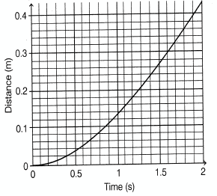MEDIUM
Earn 100
With the increase in temperature viscosity of a liquid -
(a)increases
(b)decreases
(c)remain same
(d)First increases then decreases
50% studentsanswered this correctly
Important Questions on Viscosity and Surface Tension
EASY
EASY
A flat plate of area is separated form a large plate by a layer of Glycerine thick. If the coefficient of viscosity of Glycerine is poise, the force required to keep the plate moving with a velocity of is
EASY
HARD
MEDIUM
EASY
Statement (A): When the temperature increases the viscosity of gases increases and the viscosity of liquids decreases.
Statement (B): Water does not wet an oily glass because cohesive force of oil is less than that of water.
Statement (C) : A liquid will wet a surface of a solid if the angle of contact is greater than .
EASY
EASY
HARD
A steel ball is dropped in a viscous liquid. The distance of the steel ball from the top of the liquid is shown below. The terminal velocity of the ball is closest to

MEDIUM
MEDIUM
EASY
MEDIUM
MEDIUM
MEDIUM
EASY
MEDIUM
EASY
HARD
MEDIUM

